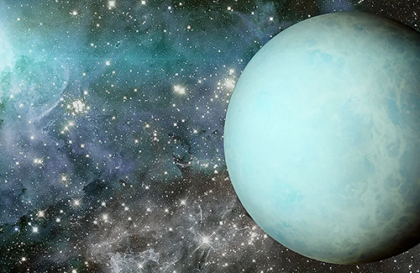Uranus: Uranus is the coldest planet in our solar system. Despite its closer proximity to the Sun compared to Neptune, it has a lower average temperature. The upper atmosphere of Uranus can reach temperatures as low as -224 degrees Celsius (-371 degrees Fahrenheit).
Neptune: Neptune comes second in terms of coldness. It’s a bit farther from the Sun than Uranus and has an average temperature of around -218 degrees Celsius (-361 degrees Fahrenheit). It’s the farthest planet from the Sun and receives less sunlight, contributing to its coldness.
Why is Uranus colder?
No, Uranus is colder not because it is closer to the Sun. Although the main reason for the extremely low temperatures on Uranus and Neptune is their distance from the Sun.
Uranus: The average distance from Uranus to the Sun is about 2.9 billion kilometers (1.8 billion miles), or about 19 astronomical units.
Neptune: The average distance from Neptune to the Sun is about 4.5 billion kilometers (2.8 billion miles), or about 30 astronomical units.
Uranus and Neptune are gas giants located in the outer region of our solar system, also known as “ice giants” because of their composition of water, ammonia, and methane ice.
Uranus is colder because of the way it processes solar energy:
Uranus has a slightly different atmospheric composition and lacks the thicker methane layer that Neptune has, which affects its ability to capture and distribute solar heat.
Neptune, similar to Uranus in size and composition, radiates 2.61 times more heat energy into space than it receives from the Sun. Uranus emits almost no heat.
Where do planets get their internal heat from?
Planets like Earth and to some extent gas giants like Jupiter and Saturn, Uranus, and Neptune have internal heat due to several factors:
During planet formation, particles and materials come together because of gravitational attraction. Kinetic energy from the collisions is converted into heat. This is especially important in the early stages of planet formation.
As the planet forms, heavier materials sink toward the center of the planet because of their higher density. This process, known as differentiation, releases heat as potential energy is converted into kinetic energy.
Some planets have internal heat generated by the decay of radioactive isotopes in their interior. Elements such as uranium, thorium, and potassium decay over time, releasing heat as a byproduct.
Was heat knocked out of Uranus?
According to one version, Uranus lost some of its internal heat after a collision with a large celestial body, which knocked out some of the heat and turned Uranus on its side. Yes, it revolves around the Sun like a wheel, its axis is almost in the plane of the planetary disk. The collision occurred at an early stage in the formation of the planets of the solar system.
How to measure the temperature on Uranus?
I want to emphasize to note that Uranus’ extreme axial tilt (it rotates almost on its side) causes seasonal changes in its temperature distribution, with poles experiencing prolonged periods of sunlight and darkness. This makes temperature measurements and modeling more challenging.
Due to Uranus’ great distance from Earth, direct contact or surface measurements are not feasible. Instead, astronomers use various methods to estimate its temperature:
- Infrared Observations: Uranus emits thermal radiation in the form of infrared light due to its internal heat and absorbed sunlight. Infrared telescopes, both ground-based and space-based (like the Spitzer Space Telescope), can detect this radiation and help scientists estimate the planet’s temperature. Different layers of Uranus’ atmosphere radiate at different temperatures, allowing scientists to study its thermal structure.
- Spectroscopy: By analyzing the spectrum of sunlight that has passed through or been reflected by Uranus’ atmosphere, scientists can identify absorption lines corresponding to specific molecules. These lines can reveal the temperature and composition of different atmospheric layers.
- Thermal Maps: Spacecraft like Voyager 2, which flew by Uranus in 1986, have instruments that can create thermal maps of the planet’s atmosphere. By measuring the heat radiating from different regions, scientists can infer temperature variations across the planet.
- Modeling: Complex computer models simulate the planet’s atmospheric processes, taking into account factors like sunlight absorption, convection, and heat distribution. These models can help researchers understand how temperature changes at different altitudes and latitudes on Uranus.
What is Uranus hiding?
There is a layer in the upper layers of Uranus that prevents heat from the core from reaching the upper layers. For example, if neighboring layers have different compositions, convective transport of heat from the core upwards may be hindered. This is a hypothesis.
It means that we can’t measure the temperature at the surface. We measure the temperature of some sort of blanket shell that envelops Uranus.
Of course, the planet’s lack of excess thermal radiation makes it much more difficult to determine the temperature of its interior. But if we assume that the temperature conditions inside Uranus are close to those of other giant planets, then liquid water may exist there and, therefore, Uranus is potentially suitable for life. Life could exist there.
Image credit:
https://interestingengineering.com


